
The Atomic Bomb and the End of World War II: A Collection of Primary Sources, National Security Archives
A Country At War

The Atomic Bomb and the End of World War II: A Collection of Primary Sources, National Security Archives
In 1945 World War II was raging in the Pacific. During WWII, Paul Muller, a chemist, discovered that a compound called DDT was a potent insecticide. It was rushed to battlefields to treat insect-spread diseases like typhus and malaria. When World War II was finally won, credit for victory was given to the two major scientific advancements of the era: the atom bomb and the Insect Bomb, DDT. DDT was celebrated, after saving so many from disease.

Paul Muller, creator of DDT.
Encyclopædia Britannica

A crop duster spraying a field of crops with DDT.
Pesticide Action Network
The invention of DDT began America’s war against nature. Spray stations sprayed entire populations with DDT to control outbreaks of typhus and malaria. In the pacific, entire islands were drenched with DDT. Chemical companies were not legally required to perform any rigorous safety testing. Regulations involving new products were largely unrestrictive. Society was beginning to believe that science could solve any problem with the power of chemicals.

U.S. soldiers spraying a man and his coat with pesticides to prevent typhus and malaria.
PBS, Public Broadcasting Service